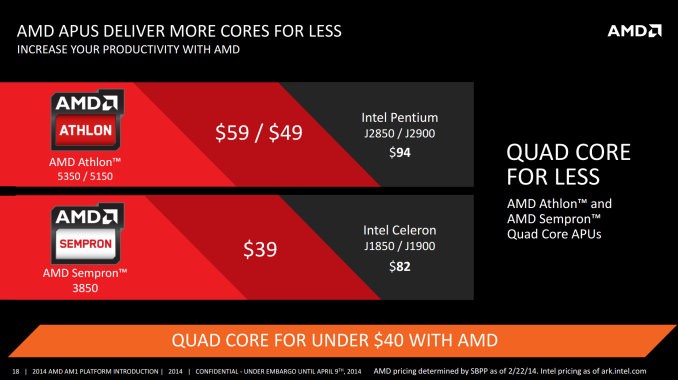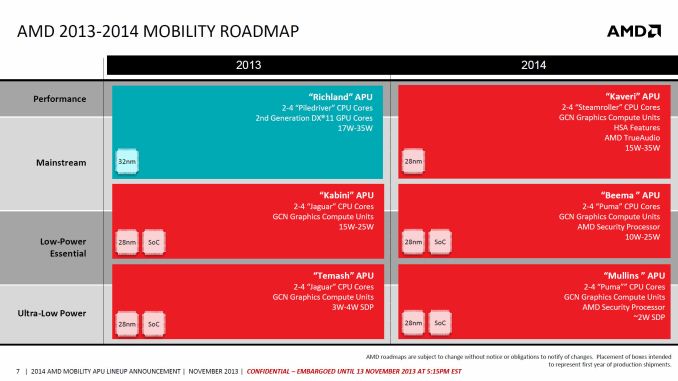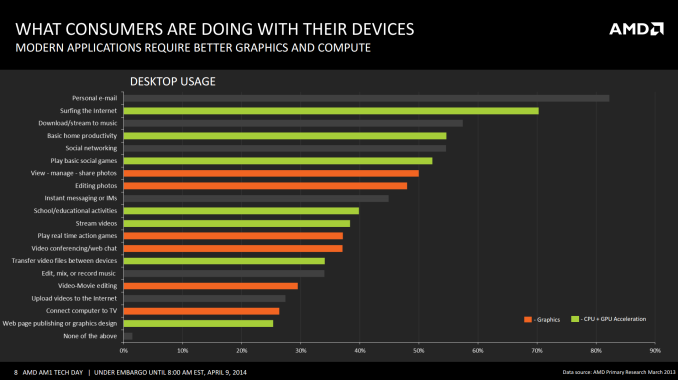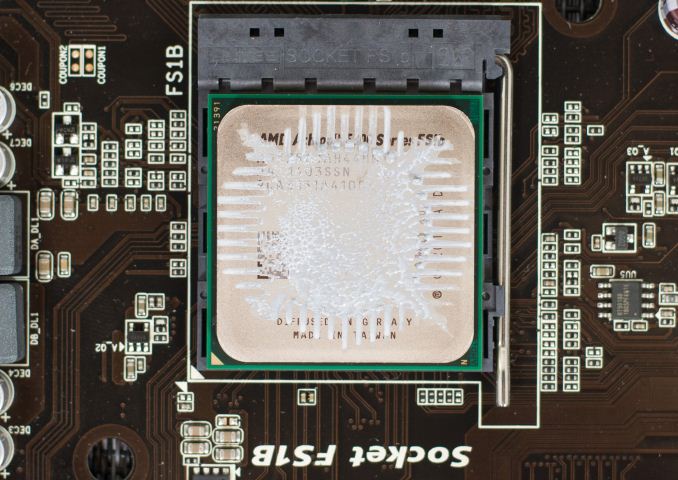The Desktop Kabini Review Part 1: AMD Athlon 5350 (AM1) Tested
by Ian Cutress on April 9, 2014 8:00 AM ESTFinal Words
As mentioned in our test setup, the benchmark results in this preliminary article are only a small fraction of our normal coverage. Due to other commitments we were unable to run every test on all comparison systems, but we have the other Athlon and Sempron APUs as well as comparable Intel counterparts coming in for review.
The poignant place to start with the final analysis is AMD’s claim of ‘Quad Core for Less’. In this statement alone, they are not wrong. Intel cannot provide a socketed quad core processor for less than $36 (Sempron 3850). The cheapest all-in-one desktop quad-core system from Intel equips the Celeron J1900 onto a motherboard for $92, which is exactly where AMD sit with the top-end Kabini based Athlon 5350 with a motherboard. One of the issues to consider at this point however is that Intel offers several dual core options (non-Atom) around this $40-$60 price point, and in many cases the IPC and CPU speed advantage of these cores is greater than that provided by Kabini, particularly in single threaded applications. The only downsides to this solution are the power consumption is higher, and the motherboards are more expensive. For a competitive socketed Intel dual core, a motherboard plus CPU can be in the region of $110-$120 at 35W-55W.
The big upside and selling point from the AM1 Kabini platform should be upgradeability. If a user buys an AM1 platform now, they should be able to upgrade it in the future. While AMD has not yet confirmed if Beema is coming to the socketed platform, the roadmaps suggest that the laptop sockets are remaining consistent from Kabini to Beema. This should imply that if Beema gets a socketed version, it should also remain based on AM1/FS1b.
If we compare single threaded performance between Kabini and our J1800 test system, the benchmarks are almost even between the two, particularly when it comes to synthetics such as Cinebench, but falls behind on emulation such as the Dolphin Benchmark and 3DPM. The integrated graphics of the Kabini pull ahead when it comes to gaming, despite the single channel memory interface.
|
AMD Athlon 5350 vs. Intel Celeron J1800 Single Threaded |
||
| Athlon 5350 | Celeron J1800 | |
| Cinebench R10 | 1967 | 1917 |
| Cinebench R11.5 | 0.51 | 0.49 |
| Dolphin Benchmark | 40.4 | 38.02 |
| 3DPM | 53.29 | 69.20 |
When placing Kabini against any Intel Ivy Bridge socketed processor, the increased IPC and frequency pushes the system above the Kabini, in exchange for more power and a more expensive system overall. If we compare the Kabini single-threaded results to those of the Celeron G465, a Sandy Bridge based single core CPU at 1.9 GHz, the Celeron does pull ahead on the majority, but fails miserably in the graphical benchmark suite.
|
AMD Athlon 5350 vs. Intel Celeron G465 Single Threaded |
||
| Athlon 5350 | Celeron G465 | |
| Cinebench R10 | 1967 | 2975 |
| Cinebench R11.5 | 0.51 | 0.73 |
| Dolphin Benchmark | 40.4 | 38.8 |
| 3DPM | 53.29 | 59.98 |
Does it seem particularly odd that a modern Kabini architecture at 2 GHz cannot keep up with a 3 year old Sandy Bridge processor at 1.9 GHz at our simple benchmarks? AMD is leveraging on the fact that much of what we do on a computer as a casual user can leverage the fixed function units of the graphics center of the APU:
AMD’s key in all of this is leveraging the GPU. For non-GPU intensive tasks, on paper, the J1900 for $92 and 10W TDP would seem to be the choice if upgradability is not a concern. The remit of AM1 and Kabini could be extended if motherboard manufacturers decided to use those extra PCIe lanes. Consider an AM1 with controllers to make a nice routing system (4x NIC) or something based around storage (SATA controllers and hubs). But because Kabini is also a cost play for AMD at the low-end desktop segment, margins are going to be ultra-tight for motherboard manufacturers and I do not imagine that as much effort will be put into making innovative products as the rest of their product range on other sockets.
In order for the upgradability angle to work, AMD need to keep the sockets around for at least two generations. AM1 comes late in Kabini’s life cycle, given that Beema on the mobile side is due out later in 2014. It would make sense for AMD to release Beema desktop parts, but the big question there is when. AMD could launch new processors on day 1 of Beema, or further into the life cycle. I would imagine that depends on what the competition does. AMD does have that advantage of having an upgradeable platform before Intel; however Intel may see the market differently. It is a hard one to judge.
Stay tuned for our full benchmark suite on the other AMD Kabini APUs.














126 Comments
View All Comments
Medallish - Wednesday, April 9, 2014 - link
Indeed, I loved building one, but it's kind of hard to advertise it being insanely cheap, and advertising upgradeability, you are more likely to simply purchase something new entirely when upgrading, if they are able to upgrade AM1 CPU's greatly, like lets say the next Mullins or Beema fits in effortlessly and introduces new stuff like Dual Channel DP 12a, or HDMI 2.0, and it worked on older boards, then I would say AMD had a nice idea, but the question really comes down to, at this price point do people even care about upgradeability?mikato - Friday, April 11, 2014 - link
The good thing is that if/when you do upgrade and get a Beema, you're upgrading both the graphics and the CPU, hopefully both significantly.mrdude - Wednesday, April 9, 2014 - link
I'm actually fond of AMD's APUs and their direction with respect to heterogenous computing (I think it'll succeed even if AMD goes out of business, personally), but I agree with you.Providing a socketed platform is great, but without a clear direction and upgrade path it's all for naught -- and I mean AMD needs to state that Beema will be available on X date and features Y improvements. Nobody with more than a few brain cells buys into a platform that offers nothing outside of 'wait and see.'
AMD also needs to come to grips with the fact that on-die GPUs aren't going to taken seriously until they can provide playable framerates at 1080p without substantially increasing platform cost. Kaveri does the first part very well, but the memory scaling and memory cost issue really hamstring the platform. Pushing for beefier graphics makes sense in the tablet space where Mullins is supposed to make headway, but on the laptop/desktop side it's next-to-worthless unless it can play modern titles at 720p or 1080p at medium settings.
And Kabini desperately needs an aggressive turbo core and dual-channel memory. Kanter's article shows a very potent little microarchitecture, but those two points are really holding it back.
I think Jaguar is a better microarchitecture than Steamroller, but it seems clear to me that AMD isn't giving it the sort of attention that I feel it deserves.
JDG1980 - Wednesday, April 9, 2014 - link
Backtracking on GDDR5 for Kaveri was a big mistake. Without the added memory bandwidth, the iGPU is bottlenecked, and the result is that Kaveri barely offers any improvement over Richland at all.Musafir_86 - Wednesday, April 9, 2014 - link
-It's Mantle time!-On a serious note, please test any GCN 1.1 card (Bonaire & Hawaii), and also GCN 1.0 card with BF4 & Thief in Mantle mode, pretty please! Don't let that ×16 slot go to waste!
Regards.
otherwise - Wednesday, April 9, 2014 - link
Looking at those CPU benchmarks, I would argue if you're even considering using an external GPU with this system you should be looking elsewhere. It's not really cheaper than a low end celeron system; and even atom is beating it in CPU power.Flunk - Wednesday, April 9, 2014 - link
I don't think he wants to see how it performs because he's thinking of building a rig like that. It would however be a good way to see how the reduced CPU overhead of Mantle affects GPU performance.Medallish - Wednesday, April 9, 2014 - link
Honestly it would be kind of fun/interesting to see if Mantle will have an impact at such a low-end system, I mean likely the CPU will be bottlenecked simply using a 260x.munim - Wednesday, April 9, 2014 - link
How does it work for everyday use? Web browsing, 1080p youtube, things of that nature?JDG1980 - Wednesday, April 9, 2014 - link
They don't bother testing that since any modern system will do it just fine.There were a couple of JavaScript benchmarks (SunSpider and WebXprt) at the bottom of the 'CPU Productivity' page.